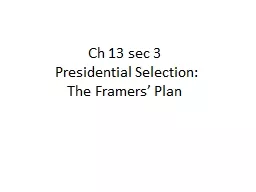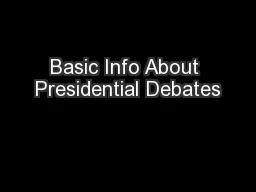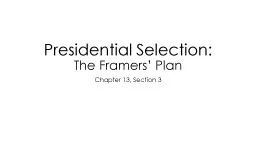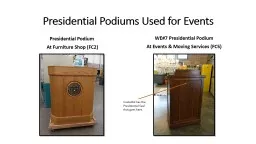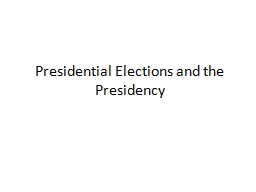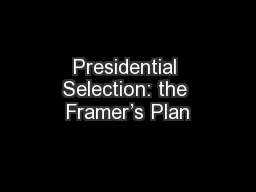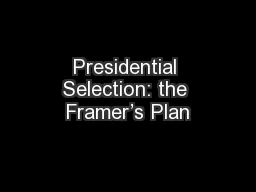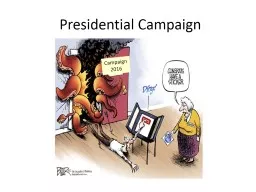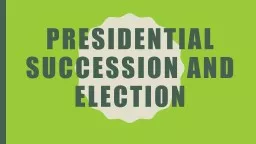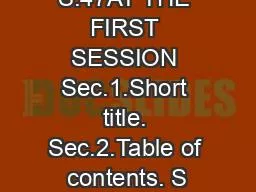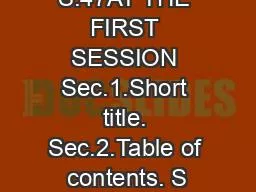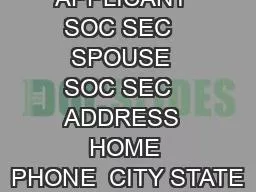PPT-Ch 13 sec 3 Presidential Selection:
Author : phoebe-click | Published Date : 2018-10-02
The Framers Plan What were the Framers original provisions for choosing the President The Original Provisions According to the Constitution the President amp Vice
Presentation Embed Code
Download Presentation
Download Presentation The PPT/PDF document "Ch 13 sec 3 Presidential Selection:" is the property of its rightful owner. Permission is granted to download and print the materials on this website for personal, non-commercial use only, and to display it on your personal computer provided you do not modify the materials and that you retain all copyright notices contained in the materials. By downloading content from our website, you accept the terms of this agreement.
Ch 13 sec 3 Presidential Selection:: Transcript
The Framers Plan What were the Framers original provisions for choosing the President The Original Provisions According to the Constitution the President amp Vice President are chosen by a special body of . MOHAWKGROUP.COM VACUUMING SEC. SEC. SEC. SEC. SEC. 101CARPET CARE THE FIVE KEYS TO EFFECTIVE MAINTENANCE 4.0 INTERIM CLEANING Scheduled interim cleaning helps the carpet retain appearance, and im Who . sponsors the Presidential . Debates?. Types of Debates – Toughest type. What . criteria do you have to meet to participate in a debate? . Is . a candidate required to participate in a debate? . The Framers’ Plan. Chapter 13, Section 3. Constitutional Provisions . (Selecting the President). The framers did not believe that the people of the new nation would be able to adequately elect the President.. Presidential Podium. At PMCS Furniture Shop (FC2). WE#7 Presidential Podium. At Events & Moving Services (FC5). (Preferred by University Events). Custodial has the Presidential Seal that goes here.. The Road to the Presidency. The Presidential Primaries. In the early 1800s, congressional leaders held a caucus to select presidential candidates.. Supporters of Andrew Jackson criticized the caucus system for being elitist.. Chapter 13. Section 3. Presidential elector. Electoral vote. Electoral College. Key Terms. Original Provisions. The Framer’s gave more time . to the matter of . choosing a president then any . other matter . Neelesh B. . Mehta. ECE Department, IISc. New Project Proposal. Outline. Research problem and applications . Proposed approach. Author. ’. s previous work in this area. Project milestones. Budget estimates. Chapter 13. Section 3. Presidential elector. Electoral vote. Electoral College. Key Terms. Original Provisions. The Framer’s gave more time . to the matter of . choosing a president then any . other matter . Candidates. Though the 2016 Presidential race has seen an abnormally large number of Presidential hopefuls entering the race, it is not unusually to have several candidates on both the democratic and republican sides. However, to ensure the party gets someone into office, Political Parties will only officially nominate 1 presidential candidate. . Presidential Succession & the Vice Presidency. Presidential Succession. Presidential Succession. : The scheme by which a presidential vacancy is filled. .. Article II is vague regarding Presidential succession…does not explicitly state whether the V.P. is an “Acting President” as opposed to a “true” President.. S.47 S.47 /Vol 86 No 15/Tuesday January 26 2021/Presidential Documents VerDate Sep2322 Jan 25 2021Jkt 253001PO 00000Frm 00001Fmt 4790Sfmt 4790EFRFM26JAO0SGM26JAO0/Vol 86 No 15/Tuesday January 26 2021/Presidenti ADDRESS 1 2 3 TRUTH IN LENDING DISCLOSURESCREDIT APPLICATION
Download Rules Of Document
"Ch 13 sec 3 Presidential Selection:"The content belongs to its owner. You may download and print it for personal use, without modification, and keep all copyright notices. By downloading, you agree to these terms.
Related Documents

